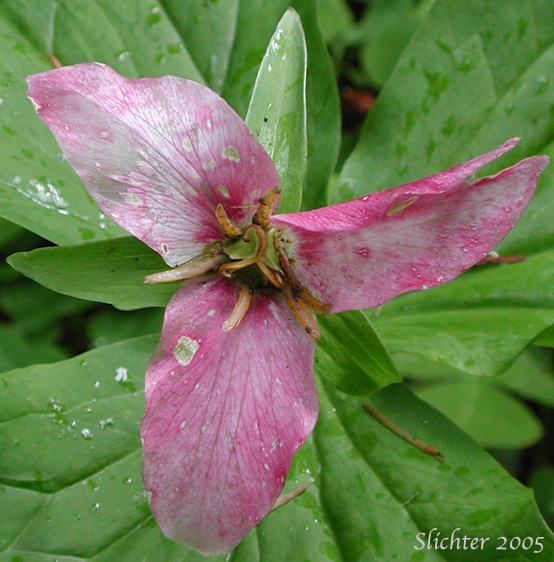
 Characteristics:
Characteristics:
The trillium or western wake-robin as it is sometimes known is an attractive perennial wildflower suitable for shady woodland gardens. Plants arise early in spring, flower, and typically disappear by midsummer. The single stem measures 10-30 cm high and usually has 3 (occasionally 4-5) leaves at midstem or higher. Individual leaves are broadly ovate to deltoid-ovate in shape and measure 5-15 cm long and nearly as wide.
The flower sits atop a 2-8 cm stalk. The 3 sepals are green and range from 1.5-6 cm long. They are narrowly oblong to oblong-elliptic in shape. The 3 (occasionally 4-5) white petals are 3-7 cm long and up to 3 cm wide. They frequently age to a lavender, reddish or pinkish color (See photo above and at right.). This color change may signal insects that pollination has already occurred. The petals are lance-ovate to elliptic in shape. The filaments of the 6 stamens are 3-6 mm long and the cream to light yellow anthers measure 6-14 mm long. The capsule is broadly ovoid and narrowly winged. It commonly turns purplish red as it ages.
As mentioned above, trilliums are attractive and fairly long-bloomed wildflowers for the woodland garden. Plants should only be dug from the wild when the location is under imminent threat of development. If this is the case, one should dig deeply around the base of the plant to ensure digging up the short, thick horizontal to erect rhizome. Plants are perhaps most easily dug and transplanted when they are dormant.
Digging wild plants is discouraged because they are easily obtained from nurseries (especially those specializing in wild plants) on the west side of the Cascades. Because they are so easily grown from seed, one can purchase 4-6" pots at reasonable prices to plant in the garden. Once planted, young plants need to sit undisturbed for several years before they have increased in size enough to produce flowers, but the wait is worth it! To my knowledge, they tend to be generally pest free.
Western wake-robin is found in open to moist, shady woods and along streambanks.
Western wake-robin may be found from coastal British Columbia south to central California and east to the Rocky Mountains of southwestern Alberta, Idaho, Montana, Wyoming and Colorado.
In the Columbia River Gorge it may be found between the elevations of 100'-4400' between Troutdale, OR and the Twin Tunnels west of Mosier, OR.
Several color variations of the flowers due to how the bloom of the individual plant has advanced for western wood lilies seen at the White Salmon Oak NRCA, Klickitat County, WA.....April 23, 2024. The plant at left was pollinated several days prior to the photo and is changing colors (supposedly insects don't recognize the flower as "open" for business) the flower at right was pollinated within a day or so a it is just changing colors.